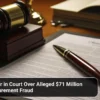DroneShield Limited (ASX: DRO) has submitted a detailed response to an Australian Securities Exchange aware letter following controversial director share sales totalling approximately $67 million. The counter-drone technology company addressed 24 questions from regulators about director share disposals, compliance procedures, and an incorrectly announced contract.
The DroneShield director share sales occurred between 6 and 12 November 2025, shortly after performance options vested when the company achieved a $200 million revenue milestone. CEO Oleg Vornik sold shares worth $49.5 million, chairman Peter James disposed of $12.4 million, and director Jethro Marks offloaded $4.9 million.
Market reaction was swift and brutal. The share price plummeted from $3.28 to an intraday low of $2.25 on 13 November, triggering the DroneShield ASX Aware letter.

Oleg Vornik, CEO & Managing Director
The Performance Options Trigger
DroneShield’s troubles began with success. The company granted performance options to directors and employees back in early 2024 when annual revenue sat at approximately $54 million. The vesting condition required achieving $200 million in revenue or cash receipts within any rolling 12-month period.
That represented a significant stretch target at the time. Yet DroneShield smashed through it, with the board announcing on 4 November that vesting conditions for 44,455,000 performance options had been satisfied.
On 5 November, 31,161,833 options were exercised and shares issued. The three directors lodged Appendix 3Y forms disclosing their option exercises. A trading window opened on 6 November.
What followed has raised serious questions about corporate governance and transparency at one of Australia’s hottest defence stocks.
ASX Fires Off 24 Questions
The securities regulator pulled no punches in its 13 November query letter. ASX sought explanations on multiple fronts:
- Whether director share sale agreements constituted material market information
- When DroneShield became aware of directors’ selling intentions
- Compliance with the company’s trading policy requirements
- The validity of a cleansing notice issued on 5 November
- Details of a withdrawn $7.6 million contract announcement
- Potential “ramping” conduct regarding sales pipeline disclosures
The exchange demanded granular detail, including copies of approval requests, file notes from internal discussions, and day-by-day breakdowns of sales volumes.
DroneShield’s Defence
In its comprehensive 20 November response, DroneShield defended the transactions while acknowledging some procedural shortcomings.
The company stated it only became aware of the sales after market close on 12 November. Directors sold shares on-market through programmed trading parameters agreed with their brokers, not via any coordinated agreement.
DroneShield emphasised that directors retained vested options over shares, meaning they didn’t dispose of their entire security holdings. Vornik kept 193,167 vested options, James retained 250,000, and Marks held onto 40,000.
The sales aimed to cover substantial tax liabilities arising from option exercises, the company explained. DroneShield argued this is well understood by investors who commonly participate in equity markets.
“The exercise of the Performance Options would crystalise the sale of a material proportion of the shares issued in order to meet the significant tax liability,” DroneShield stated in its response.
Trading Policy Compliance Questions
While DroneShield confirmed substantial compliance with its trading policy, some gaps emerged. Directors sought and received approval to sell up to 100% of newly issued shares on 5 November, the same day shares were issued.
However, the company’s policy requires key management to discuss significant sales with the board and document those discussions. DroneShield confirmed clause 5.4 of its trading policy had been “enlivened” on 1 November, but noted that at that time no final decision about sales parameters had been made.
Trades were notified to the company within five business days per ASX requirements, rather than the two-day internal policy requirement.
DroneShield announced plans to engage external advisers to review its securities trading policy and adherence practices.
The Contract Announcement Fiasco
Compounding the controversy, DroneShield had to withdraw a 10 November announcement about three contracts totalling $7.6 million. The company initially described these as new orders from a US government customer.
In reality, the contracts were reissued existing orders for regulatory update purposes. One had been previously announced in September 2025.
DroneShield blamed an administrative error. The US counterparty’s correspondence indicated the orders were new purchase orders, when they actually intended to resubmit prior orders internally. The US representative failed to perform necessary manual checks before distributing the order internally.
This marked the first such error since the company’s 2015 incorporation, DroneShield emphasised. The mistake occurred despite existing validation processes, which flagged the orders as potential duplicates the following morning in Sydney.
Market Impact and Broker Views
The combined effect of director share sales and the contract withdrawal has been devastating for shareholder confidence. The stock traded around $6.70 in early October before collapsing to below $2.00 by late November.

Bell Potter, DroneShield’s house broker, reportedly called the stock “dead money” for the remainder of 2025. The broker suggested institutional investors would remain on the sidelines until confidence rebuilds.
Further pressure came when US CEO Matt McCrann resigned effective immediately on 19 November, with no explanation provided. That news triggered another 19% single-day decline.
Systemic Improvements Planned
DroneShield is implementing new enterprise resource planning (ERP) and customer relationship management (CRM) systems scheduled to go live in January 2026. These aim to automate order processing and eliminate manual verification errors.
The company has engaged external auditors HLB Mann Judd to review proposed processes and internal controls. Additional reviews of continuous disclosure policies and broader financial controls are planned once new systems launch.
For contract announcements, DroneShield stated its materiality threshold will increase from $5 million to $20 million from 2026, reflecting substantial revenue growth.
Also Read: DroneShield US CEO Walks Out as Leadership Crisis Deepens
Looking Forward
Despite governance concerns, DroneShield’s underlying business remains strong. The company reported record quarterly growth and positive operating cashflow in its most recent update. Sales pipeline stands at approximately $2.55 billion across more than 300 projects globally.
The critical question is whether management can rebuild trust while maintaining operational momentum. As corporate governance becomes increasingly scrutinised across ASX-listed companies, DroneShield’s handling of this episode will be closely watched.












